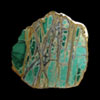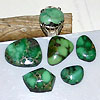- sale
- new items
- lovely beads
- wedding beads
- beads for teens
- for custom order
- newsletter
- recognition
- testimonials
- birthstones
- zodiac signs
- jewelry guide
SHOP BAG
![]() in your bag 0 items
in your bag 0 items
Variscite is a relatively rare phosphate mineral. The material is usually veined with other minerals such as millisite or wardite. Colors of variscite vary only slightly between yellow green to slightly darker greens. The material is sometimes confused with turquoise; however, variscite is usually greener in color.
It was first described in 1837 and named for the locality of Variscia, the historical name of the Vogtland, in Germany, where the mineral was first discovered. At one time, variscite was called "utahlite" by the name of the state in the USA where variscite is widely mined. At times, materials which may be turquoise or may be variscite have been marketed as "variquoise".
Variscite is actually quite rare, it is inexpensive because it is not a well known, therefore there is little demand for it. Appreciation of the color ranges typically found in variscite have made it a popular gem in recent years, it is popular for carvings and ornamental use. Variscite is cut en cabochon (with a round, convex, polished surface) for brooches, earrings, and beads and is frequently substituted for turquoise. It also is carved into bowls or other decorative objects. Because of its porosity, it tends to absorb grease and oil, which discolor it.
Notable localities are Lucin, Utah and Fairfield, Utah in the United States. It is also found in Germany, Australia, Poland, Spain and Brazil. Variscite from Nevada typically contains black spiderwebbing in the matrix and is often confused with green turquoise. Most of the Nevada variscite recovered in recent decades has come from mines located in Lander County.



